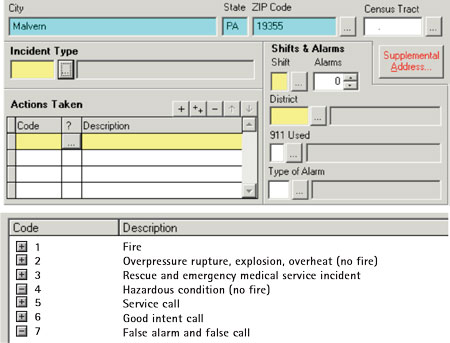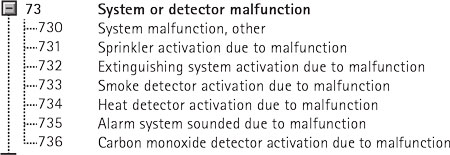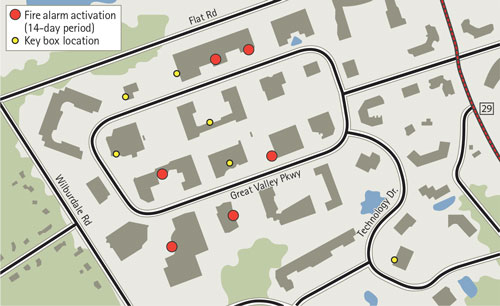BY DAN KERRIGAN
Fire alarm system activations can place a tremendous burden on fire departments. They may account for most of nonmedical responses, and it’s even more likely that many of these responses result in nothing more than a quick investigation and an alarm reset. Nevertheless, there are times when a malfunctioning system creates undue burden for responders. When do you know there is a problem? What is perception and what is reality?
Alarm Causes
Let’s distinguish false fire alarm activations from activations resulting from other causes. A false alarm is an alarm activation caused by something other than a fire or smoke condition. Common causes include system malfunctions, unintentional activations, and malicious false calls.
According to a 2013 report for the National Fire Protection Association (NFPA) by Michael J. Karter Jr., in 2012, United States fire departments responded to a reported 2,238,000 false alarms. He further explains that of the total responses, 31.9 percent resulted from system malfunctions and 46.5 percent from unintentional false calls. According to Karter, only 8.2 percent of false calls were malicious and 14 percent resulted from other reasons, including bomb scares. Further, he stated that there has been a steady increase in unintentional false calls between 1988 and 2012 (276 percent over that time period, with a few exceptions by year in 1990, 1997, 2002, 2009, and 2012). At the same time, the rate of alarm system malfunctions (which was extremely rampant between 1988 and 1999) has dropped 20.9 percent between 2000 and 2012.
Figure 1. Incident Type Menu

In a separate 2011 report issued by the NFPA, Marty Aherns and Ben Evarts documented that of all false fire alarms in 2009, nearly half were unintentional whereas only one-third resulted from system malfunctions. What do these statistics mean to your department? Well, that depends. Although unwanted fire alarms continue to be a problem for the U.S. fire service, it’s clear that the causes have changed over the years.
We can draw some general conclusions from the data. First, the incidence of malfunctioning alarm systems has dropped steadily, most likely because of improvements in technology and stricter codes governing their installation, testing, and maintenance. Second, malicious false alarms are not nearly the problem they used to be in most jurisdictions. Third, we must consider that public training, education, inspection, and enforcement opportunities reduce the instance of unintentional alarms. Regardless of jurisdiction, the primary means to accurately determine what’s causing false alarm activations is through data collection and analysis.
Data-Based Decision Making
If your department is not collecting data on fire alarm activation responses, then you can’t really say for sure whether or not a problem exists. Battalion Chief/Fire Marshal Ted Sweetser of the Las Cruces (NM) Fire Department indicated that since enacting a fire alarm billing ordinance in 2013, his department has noticed a decrease in nuisance alarms, and he believes that the drop is at least partly attributable to the new ordinance. In pursuing the ordinance, Sweetser stressed that data had to be analyzed first to gain enough support to make the change.
Figure 2. False Alarm/False Call Menu

Grant Parker, division chief/fire marshal for the Santa Cruz City (CA) Fire Department, related that his department also enacted an ordinance to help reduce the occurrence of false alarms, which he believes has had a positive impact. “The biggest problem in identifying false alarms is the way the incidents are entered into the incident database,” he said. “Our administrative assistant runs reports for all fire alarm codes to review the incident reports and determine which warrant a warning letter or a fine.” Parker also stressed the importance of training personnel in the proper methods of selecting and entering incident type codes in the reporting database to ensure accurate data.
How you determine whether there is a fire alarm problem in your jurisdiction and what you do about it are ultimately up to you, but I say that it should always be based on verifiable data, not on gut feelings or perceptions. So, let’s look at a systematic process to help you determine whether your fire alarm “problem” is what you think it is.
NFIRS: Garbage In, Garbage Out
It’s likely that many of the alarms you respond to have activated for a reason (e.g., smoke from unattended cooking, a small fire that was extinguished prior to arrival, a closed chimney flue, a sprinkler system activated by fire or a frozen pipe). These aren’t just “malfunctions.” It’s also likely that you’ve responded to countless alarm system malfunctions and unintentional activations. These responses create a huge burden on your department’s personnel and its physical assets, and they may delay or otherwise impact responses to more serious incidents. Regardless of the reason for activation, if you think there is a problem, you must use reliable data to determine what that problem is (and where it is concentrated). To do this, you need to know how to input the data correctly.
If your department uses the National Fire Incident Reporting System (NFIRS) or some other database designed to document incident responses, then you should already have some data available to help you sort through the problem. I say should because the information you extract from the database will only be as good as what was entered. So, it’s vitally important that whomever you have assigned in your department to enter incident reports into the system has been trained in the proper methods of doing so. Once you’ve accomplished this training and you add a quality control (QC) component to your incident reporting, you will be well on your way to capturing accurate data.
Figure 3. System/Detector Malfunction Menu

Most of us are familiar with the Category 7 in NFIRS (Figures 1, 2), the false alarm/false call category. You will also find all of your incident type categories relating to fire alarm system responses. Within this category, there are several incident type options to select from. For the purposes of this discussion, we will focus on the category 73 “System or detector malfunction” and category 74 “Unintentional system/detector operation (no fire)” menus, respectively (Figures 3, 4).
The system or detector malfunction menu (73) offers several choices (Figure 3). Based on your investigation and determination that there was no fire-related reason for activation, you would select the best choice from this menu to enter as your specific incident type. If, on the other hand, you were able to determine a specific (nonfire) reason for activation, you would select the appropriate incident type from the unintentional activation (74) menu (Figure 4).
In both cases, there are several very specific choices, and your selection will have a tremendous impact on the data you may query and analyze in the future. Regardless of your choice, you should make every effort to avoid choosing “System Malfunction, Other” (730) and “Unintentional Transmission of Alarm, Other” (740) unless you absolutely cannot classify the alarm more specifically.
Geographical Information Systems (GIS)
Once you have a reliable database from which to work, one of the ways to visually demonstrate potential problem areas in your jurisdiction is to apply the data to a geographical information system (GIS) program (Figure 5). Graphic depictions of incident response histories are a very useful tool for a number of reasons: (1) visually depicting problem “areas” in your jurisdiction instead of just analyzing specific addresses or occupancies, including the number and type of alarm; (2) distinguishing between different occupancy classifications (residential vs. mercantile for example) in the same area (or census tract) to highlight or identify potential issues; and (3) identifying problems based on other factors (e.g., a property management company that owns several buildings in a particular census tract whose buildings account for most of the false alarms in that area).
Figure 4. Unintentional System/Detector Activation Menu

“Another feature of GIS that goes beyond basic NFIRS reporting is the ability to identify and track information by using United States National Grid (USNG) coordinates in addition to street address information,” says Ken Battin, director of codes and life safety for East Whiteland Township (PA). “At East Whiteland Township, we’ve begun entering USNG coordinates into the Address2 line of our NFIRS incident reports to capture this more detailed layer of information for later use in GIS applications, including prefire planning and 3-D pictograph applications.”
Responsibility
I can recall a number of incidents over the years that started as fire alarm activations and ended as working fires. One was a residential fire alarm response in the middle of the night. On our arrival on the first-due engine, we were greeted by heavy smoke showing from an attached garage at a single-family residence and a family standing in their pajamas in their front yard. The fire involved an automobile in the garage, and it was quickly brought under control. After the fire was out, I asked the homeowner why he had not called the fire department to report the fire. His response was that since he knew the fire alarm system activated and he figured his monitoring company was under instructions to automatically notify the fire department, he didn’t have to do it, too. Although these situations might be uncommon, the point is, fire alarm systems do work-most of the time.
Figure 5. GIS Plotting

It’s part of our job to respond to fire alarm activations. Treat them as structure fire-related responses until reliable supplemental information tells you otherwise. Even then, it’s still very important to verify the cause for activation (I can’t tell you how many times what I was told and what I found were completely different; this goes directly to proper data input). It’s troubling to me that some fire departments, especially those that struggle with staffing, have adjusted their responses to fire alarm activations without a good understanding of why or if there is a problem in the first place. Placing an address on staff or administrative notification for a designated time period and automatically sending fire alarm activations to staff as notifications are actions that amount to playing with fire (excuse the pun). Whose word are you taking that everything is okay? What documentation do you have that a qualified person even showed up in a timely manner to verify the cause of the alarm in the first place? (I’m pretty sure that the police still respond to calls for service even if someone calls back to say everything is okay). The lack of a fire department response, even if at a nonemergency rate, can only increase potential hazard and liability. Staffing issues and wear and tear on apparatus are not going to be seen as valid reasons for failure to respond in a court of law.
When the data are analyzed in your jurisdiction and you identify a particular problem with alarm activations, understanding the cause or causes can help you to determine a course of action to rectify the situation. Remember, the data you have to work with are only going to be as good as the information that was entered in the first place. Assuming accurate data are available to review, some possible solutions include the following:
- Develop and implement a fire alarm inspection program that ensures that qualified personnel are completing applicable inspections and testing.
- Enact an ordinance that specifies fines for offenders whose malfunctioning fire alarm systems repeatedly activate.
- Develop short, targeted training programs that educate the public on fire alarm systems, system maintenance, and general fire safety concepts aimed at reducing unintentional system activations for reasons such as unattended cooking.
- Train your personnel to observe the location of specific fire alarm devices in buildings to confirm that they are properly placed for the hazard (e.g., a smoke alarm placed in a kitchen is a common cause of residential fire alarms).
- Develop and implement modified response procedures such as a nonemergency response to an alarm activation where you receive reliable information that indicates a false or a nonfire activation.
You may identify another solution to a problem in your jurisdiction that I’ve not mentioned. There is no one-size-fits-all answer to the challenges we deal with every day. Whatever the solutions you identify, if you expect to see real change, then you must develop alternatives that are based in fact, not perception.
References
Aherns, M, and B Evarts. (2011). Unwanted Fire Alarms. National Fire Protection Association. Abstract retrieved from http://bit.ly/1S4lfKB.
Karter Jr., MJ. (2013). False Alarm Activity in the U.S. 2012. National Fire Protection Association. Abstract retrieved from http://bit.ly/1MmztEP.
DAN KERRIGAN is a 29-year fire service veteran and an assistant fire marshal/department health and fitness coordinator for the East Whiteland Township (PA) Department of Codes and Life Safety and the director of http://www.thefirsttwenty.org/“>The First Twenty’s Firefighter Functional Training Advisory Panel. Kerrigan is a graduate of the National Fire Academy’s Executive Fire Officer Program and has a master’s degree in executive fire service leadership.
A Common Response to an Uncommon Fire Alarm Activation
Construction Concerns: Fire Alarm System Control Panels
AUTOMATIC FIRE ALARM RESPONSE: “THE BOY WHO CRIED WOLF” SYNDROME?
Fire Engineering Archives

